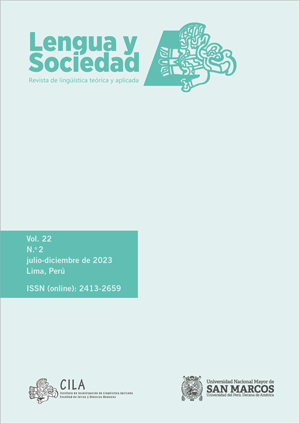Realization of the tripartite alignment in Amahuaca: synchronic analysis and diachronic explanation
DOI:
https://doi.org/10.15381/lengsoc.v22i2.24571Keywords:
Amahuaca, Panoan family, tripartite case-marking, latent consonant, proto-PanoAbstract
The native language Amahuaca (Panoan family, Peru) features a cross-linguistically unusual tripartite case-marking system whereby the subjects of intransitive and transitive verbs are signaled by means of the enclitics =x and =n, respectively, whereas the objects do not bear any morphological marking (Sparing-Chávez, 2007/2012; Clem, 2019a; among others). Another salient property of this system is the diverse realizations that nominals display when they host overt case-markers; this is, precisely, the primary focus of the present article. While these manifestations might initially appear erratic, our analysis reveals that the realizations of the marked nominals are highly predictable, especially when we posit the presence of a latent consonant that emerges phonetically in the context of =x and =n. From a diachronic perspective, we argue that this allomorphic variability can be linked to a rule proposed by Shell (1975), which is believed to have affected trisyllabic items in the protolanguage.
References
Blake, B. (1977). Case Marking in Australian Languages. Australian Institute of Aboriginal Studies
Clem, E. (2019a). Agreement, case, and switch-reference in Amahuaca [Tesis de doctorado, University of California].
Clem, E. (2019b). Amahuaca ergative as agreement with multiple heads. Natural Language & Linguistic Theory, 37, 785-823. https://doi.org/10.1007/s11049-018-9431-2
Comrie, B. (2013). Alignment of Case Marking of Full Noun Phrases. En M. Dryer y M. Haspelmath (Eds.), WALS Online. Zenodo. https://doi.org/10.5281/zenodo.7385533
Dixon, R. M. W. (1994). Ergativity. Cambridge University Press.
Dole, G. (1998). Amahuaca. En F. Santos Granero y F. Barclay (Eds.), Guía Etnográfica de la Alta Amazonía (Vol. 3, pp. 125-274). Flacso/IFEA.
Elías-Ulloa, J. (2006). Theoretical Aspects of Panoan Metrical Phonology: Disyllabic Footing and Contextual Syllable Weight [Tesis de doctorado, Rutgers University].
Hewlett, C. (2013). History, Kinship and Comunidad: Learning to Live Together Amongst Amahuaca People on the Inuya River in the Peruvian Amazon [Tesis de doctorado, University of Saint Andrews].
Hyde, R. y Loos, E. (1975). A few thoughts regarding high tone in Amahuaca. Información de Campo (Peru).
Hyde, S. (Ed.). (1980). Diccionario amahuaca. Instituto Lingüístico de Verano y Ministerio de Educación.
Hyde, S. (1973). El verbo reflexivo del amahuaca. En E. Loos (Ed.), Estudios panos II (pp. 9- 51). Instituto Lingüístico de Verano y Ministerio de Educación.
Instituto Nacional de Estadística e Informática (INEI) (2018). III Censo de Comunidades Nativas 2017. INEI.
Loos, E. (1973). La señal de transitividad del sustantivo en los idiomas panos. Serie Lingüística Peruana, 10, 133-184.
Loos, E. (Ed.). (1973). Estudios Panos I. Serie Lingüística Peruana 10. Instituto Lingüístico de Verano y Ministerio de Educación.
Loos, E. (1999). Pano. En R. M. W. Dixon y A. Y. Aikhenvald (Eds.), The Amazonian Languages (pp. 227–250). Cambridge University Press.
Montag, S. (1981). Diccionario cashinahua, tomo II. Serie Lingüística Peruana N. 9. (2.° ed.). Instituto Lingüístico de Verano.
Oliveira, S. C. S. (2014). Contribuições para a reconstrução do Protopáno [Tesis de doctorado, Universidade de Brasilia]. https://repositorio.unb.br/handle/10482/17129
Osborn, H. (1948). Amahuaca phonemes. International Journal of American Linguistics, 14, 188-190.
Russell, R. y Russell, D. (1959). Syntactotonemics in Amahuaca (Pano). Série Lingüistica Especial, 1, 128-167. Publicaçoes do Museu Nacional.
Shell, O. (1965). Pano Reconstruction [Tesis de doctorado, University of Pennsylvania].
Shell, O. (1975). Las lenguas pano y su reconstrucción, Estudios Pano III. Instituto Lingüístico de Verano y Ministerio de Educación.
Sparing-Chávez, M. (1998). Interclausal reference in Amahuaca. En D. C. Derbyshire y G. K. Pullum (Eds.), Handbook of Amazonian languages (Vol. 4, pp. 443-485). Mouton de Gruyter.
Sparing-Chávez, M. (2007). Aspects of Grammar: Amahuaca: An Endangered Language of the Amazon Basin. Summer Institute of Linguistics.
Sparing-Chávez, M. (2012). Aspects of Amahuaca grammar: An endangered language of the Amazon basin. SIL International.
Valenzuela, P. (2008). Pano ethnonyms and linguistic human rights. UniverSOS, Revista de Lenguas Indígenas y Universos Culturales, 5, 57-63.
Valenzuela, P. (1998). El Morfema de Ergatividad en el Shipibo-Conibo. En L. Miranda y A. Orellana (Eds.), Actas del II Congreso Nacional de Investigaciones Lingüístico-Filológicas (pp. 217-245). Universidad Ricardo Palma.
Valenzuela, P. (2003). Transitivity in Shipibo-Konibo Grammar [Tesis doctoral, University of Oregon].
Valenzuela, P., Zariquiey, R. y Angulo, C. [En prep.]. Esbozo gramatical de la lengua amahuaca.
Zariquiey, R. (2015). Bosquejo gramatical de la lengua iskonawa. Latinoamericana Editores y Centro de Estudios Literarios Antonio Cornejo Polar-CELACP.
Zariquiey, R. (2018). A Grammar of Kakataibo. De Gruyter Mouton.
Zariquiey, R. y Valenzuela, P. [En preparación]. Pano. En P. Epps y L. Michael (Eds.), Amazonian Languages, an International Handbook. Mouton de Gruyter.
Zariquiey, R., Valenzuela, P. y Angulo, C. [En preparación]. Nasalización en amahuaca: coalescencia nasal, post-oralización y prosodia de la palabra en una lengua pano de las cabeceras. Manuscrito inédito. Proyecto “Computational Tool and Corpora Development in a Language with Complex Clause-marking”, National Science Foundation.
Zariquiey, R., Valenzuela, P., Angulo, C. y Collazos, W. [De pronta publicación]. Acento y tono en Amahuaca: una primera aproximación a los complejos patrones prosódicos de una lengua pano de las cabeceras.
Downloads
Published
Issue
Section
License
Copyright (c) 2023 Pilar Valenzuela, Roberto Zariquiey, Candy Angulo

This work is licensed under a Creative Commons Attribution 4.0 International License.
AUTHORS RETAIN THEIR RIGHTS
a. Authors retain their trade mark rights and patent, and also on any process or procedure described in the article.
b. Authors can submit to the journal Lengua y Sociedad, papers disseminated as pre-print in repositories. This should be made known in the cover letter.
c. Authors retain their right to share, copy, distribute, perform and publicly communicate their article (eg, to place their article in an institutional repository or publish it in a book), with an acknowledgment of its initial publication in the journal Lengua y Sociedad.
d. Authors retain theirs right to make a subsequent publication of their work, to use the article or any part thereof (eg a compilation of his papers, lecture notes, thesis, or a book), always indicating its initial publication in the journal Lengua y Sociedad (the originator of the work, journal, volume, number and date).






